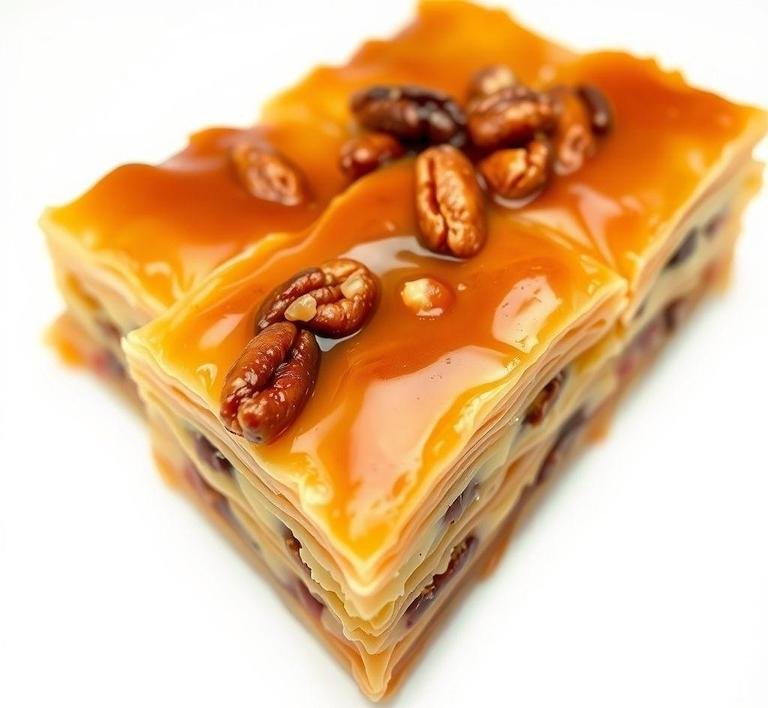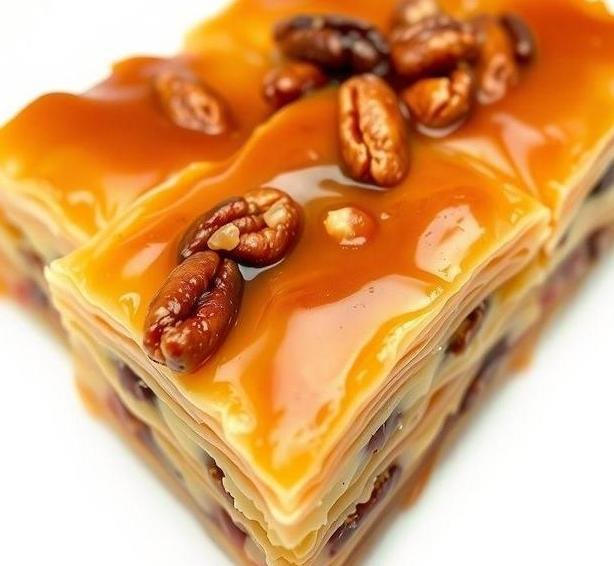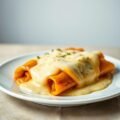Baklava is a timeless dessert with roots tracing back to the Middle East, the Mediterranean, and the Balkans. It’s a layered pastry known for its crisp, flaky texture and its luscious, nutty filling drenched in fragrant syrup. The magic lies in its delicate balance of crunchy phyllo (or filo) pastry sheets, toasted nuts, and a sweet syrup that often carries hints of honey, rosewater, or citrus.
Mary Berry’s baklava recipe is a refined take on this classic treat, designed to be approachable yet authentic. Unlike some more complex versions, her recipe emphasizes simplicity without sacrificing that signature rich, sticky sweetness and satisfying crunch. Mary’s baklava is lovingly layered with chopped nuts-typically walnuts and almonds-and spiced with warming cinnamon, then baked to golden perfection. Finally, it’s soaked in a honey-lemon syrup that seeps into every flaky layer, making each bite a delightful harmony of textures and flavors.
This dessert isn’t just a sweet finish to a meal-it’s a conversation starter, an impressive centerpiece, and a little celebration of culinary tradition. Whether you’re hosting guests or just treating yourself, Mary Berry’s baklava invites you to experience a slice of history wrapped in buttery, nutty goodness.
Mary Berry’s Baklava Recipe
Ingredients Needed

To create this luscious baklava, Mary Berry keeps it straightforward but rich with quality ingredients. Here’s the full list:
- Phyllo (filo) pastry sheets – The thin, almost translucent sheets are the backbone of the baklava’s flaky layers.
- Mixed nuts – A blend of walnuts and almonds, finely chopped. These bring both texture and flavor. Some recipes include pistachios or hazelnuts, but Mary sticks to a classic combo.
- Butter – Melted and brushed between each phyllo layer to give the pastry that golden, crispy finish.
- Ground cinnamon – Adds warmth and a subtle spice that elevates the nutty filling.
- Sugar – Granulated, to sweeten the nut mixture and to help with the syrup.
- Honey – A key ingredient for that sticky, fragrant syrup that soaks into the baked layers.
- Water – For the syrup base.
- Lemon juice – Adds a slight tang to balance the sweetness of the honey syrup, preventing it from becoming cloying.
Each ingredient plays an essential role, working harmoniously to create the perfect bite-crisp, nutty, and dripping with sweet syrup.
Equipment Needed
While baklava may seem complicated, the equipment list is surprisingly simple, which makes it perfect for home cooks:
- A large baking dish or tray (around 9×13 inches) – This is where you layer and bake the baklava.
- Pastry brush – To generously brush melted butter between each phyllo sheet.
- Mixing bowls – One for the nut mixture, another for the syrup.
- Sharp knife – For chopping nuts and scoring the baklava into pieces before baking.
- Saucepan – To prepare the honey-lemon syrup.
- Measuring cups and spoons – For accuracy in ingredients.
- Oven – Preheated to the right temperature for that golden bake.
These tools are typically already in most kitchens, so you don’t need any specialized equipment to whip up this stunning dessert.
Instructions To Make Mary Berry’s Baklava
Let’s break it down step-by-step so you can follow along easily:
-
Prepare the nut mixture:
Finely chop the walnuts and almonds and mix them in a bowl with sugar and ground cinnamon. The sugar helps bind the nuts slightly and adds sweetness, while the cinnamon gives that warm, comforting flavor.
-
Melt the butter:
Gently melt unsalted butter in a saucepan or microwave. This melted butter will be brushed over each layer of phyllo to ensure crispiness and richness.
-
Layer the phyllo pastry:
Lightly grease your baking dish, then place one sheet of phyllo pastry down. Brush generously with melted butter. Repeat this process for several layers-usually about 8 to 10 sheets to form a sturdy base.
-
Add the nut filling:
Spread a generous layer of the nut mixture evenly over the buttered phyllo base.
-
Repeat layering:
Continue layering phyllo sheets, each brushed with butter, then another layer of nut mixture. Finish with a final top layer of 8 to 10 phyllo sheets, buttering each one thoroughly.
-
Score the baklava:
Using a sharp knife, carefully score the assembled pastry into diamond or square shapes. This makes it easier to cut after baking and allows the syrup to penetrate.
-
Bake:
Bake in a preheated oven at about 180°C (350°F) for 30-40 minutes, or until the phyllo is crisp and golden brown.
-
Prepare the syrup:
While the baklava bakes, combine honey, water, sugar, and lemon juice in a saucepan. Bring to a gentle boil and then simmer until slightly thickened.
-
Pour syrup over baklava:
Once the baklava comes out of the oven, immediately pour the warm syrup evenly over it, letting it soak in deeply.
-
Cool and serve:
Let the baklava cool completely to allow the syrup to absorb fully and the layers to set. Then serve pieces as indulgent as they are impressive.
Tips And Tricks
- Handle phyllo with care: Phyllo dries out quickly when exposed to air, so keep the sheets covered with a damp tea towel while you work.
- Be generous with butter: The butter is key to the flakiness and golden color, so don’t skimp.
- Chop nuts finely but not too fine: You want a nice texture, so aim for a coarse chop rather than a powder.
- Score before baking: This makes serving easier and ensures the syrup penetrates evenly.
- Make the syrup ahead: You can prepare the honey syrup in advance and reheat it before pouring over the hot baklava.
- Rest time is crucial: Letting the baklava rest for several hours or overnight intensifies the flavor and allows the syrup to soak perfectly.
- Experiment with nuts: If you’re feeling adventurous, swap in pistachios or add a few cardamom pods to the syrup for an exotic twist.
Mary Berry’s baklava is a brilliant blend of simplicity and tradition, taking you on a sensory journey through layers of crisp, buttery pastry, fragrant nuts, and honeyed syrup. With straightforward ingredients and a few essential kitchen tools, this recipe invites both bakers and dessert lovers to create a stunning, indulgent treat that feels both timeless and special. Whether it’s for a festive occasion or a weekend project, making Mary’s baklava is more than just baking-it’s about celebrating a rich heritage of flavor, texture, and sweet satisfaction. So go ahead, dive into this decadent delight, and watch your kitchen fill with the warm, inviting aroma of one of the world’s most beloved desserts.
Easy Recipe Variations For Mary Berry’s Baklava

Mary Berry’s baklava recipe is a timeless classic-delicate layers of crisp, golden filo pastry, nestled with a fragrant mixture of nuts, and drenched in a sweet, honeyed syrup. But one of the best things about baklava is how wonderfully versatile it is. You don’t have to stick strictly to the traditional recipe; slight tweaks can elevate or transform the dish to suit different tastes and occasions.
Nut Variations:
While the classic recipe often uses a blend of walnuts and pistachios, why not experiment? Almonds add a lovely mild sweetness and a pleasant crunch, while hazelnuts bring a rich, buttery flavor that pairs beautifully with honey. For a Middle Eastern twist, you can even try a combination of pine nuts and pistachios, which adds an almost creamy texture and depth of flavor. For the more adventurous, mixing in chopped pecans or even macadamia nuts can offer surprising new dimensions.
Spices and Flavors:
Mary Berry’s baklava often calls for a hint of cinnamon or cardamom, but you can expand this spice palette to make it more aromatic and personal. Try adding ground cloves, a pinch of nutmeg, or even a dash of allspice to the nut filling. For a citrus twist, finely grated orange or lemon zest incorporated into the syrup or nuts can brighten the dish with fresh, zesty notes. Rose water or orange blossom water infused into the syrup adds a delicate floral aroma that instantly transports you to the bazaars of Istanbul.
Sweeteners and Syrup Alternatives:
Traditional baklava syrup is made with honey and sugar, but you can substitute or combine these for different textures and tastes. Maple syrup, for example, gives a smoky sweetness that complements the nuts wonderfully. For a lighter option, use agave nectar or a simple sugar syrup infused with lemon juice and spices. For a vegan twist, ensure the syrup is made without honey, substituting with pure maple syrup or date syrup, keeping the baklava delicious and inclusive.
Texture Tweaks:
Mary’s recipe uses filo sheets brushed generously with melted butter, but you can experiment with adding a touch of clarified butter or even coconut oil to introduce a subtle richness and slightly different crispness. For an extra crunch, sprinkle some toasted sesame seeds or chopped nuts between the layers, or lightly toast the nuts before mixing to bring out deeper aromas.
By making these small but effective variations, you can keep the essence of Mary Berry’s baklava while tailoring it to your flavor preferences or dietary needs-making every batch uniquely yours.
Storing Leftovers
Baklava is a decadent treat, and luckily, it tends to keep well if stored properly-because let’s be honest, it rarely sticks around long enough for leftovers!
Room Temperature Storage:
If you plan to enjoy your baklava within a couple of days, storing it at room temperature is ideal. Place the baklava in an airtight container or cover the dish tightly with plastic wrap. This prevents the syrup from drying out and keeps the filo crisp. Avoid refrigeration if you want to maintain that signature flaky texture-cold air tends to soften filo, making it soggy over time.
Refrigeration:
If you live in a particularly warm or humid climate, or if your baklava contains fresh ingredients like cream or fruit, refrigerating it is necessary. Wrap it well in cling film or store in an airtight container to prevent it from absorbing other fridge odors. When ready to eat, allow it to come to room temperature or gently warm it in a low oven (around 150°C/300°F) for 5-10 minutes to revive the crispness of the filo.
Freezing Baklava:
Baklava freezes surprisingly well, making it a great make-ahead dessert for parties or unexpected guests. To freeze, cut the baklava into portions, wrap each piece tightly in plastic wrap, then place them in a freezer-safe container or zip-lock bag. When thawing, do so overnight in the fridge and reheat in the oven as mentioned above for best results. Keep in mind the syrup can sometimes separate a little on thawing, but a quick warm-up restores that luscious harmony.
Proper storage ensures that every bite of leftover baklava is just as enjoyable as the first – crisp, sweet, and nutty, with that irresistible honeyed finish.
What To Eat With Mary Berry’s Baklava?
Baklava is richly sweet and nutty, and while it’s a star dessert on its own, pairing it thoughtfully can create a memorable culinary experience.
Beverage Pairings:
Baklava pairs beautifully with strong, aromatic teas-think Turkish black tea or a fragrant chai, where the spices complement the nuts and honey. A well-brewed coffee, such as espresso or rich Turkish coffee, balances the sweetness with its robust bitterness. For those who prefer something cold, a glass of lightly sweetened iced mint tea refreshes the palate wonderfully.
Complementary Flavors:
Serve baklava alongside fresh fruit to add a burst of freshness. Juicy figs, pomegranate seeds, or slices of ripe pear or apple cut through the richness and provide textural contrast. A dollop of Greek yogurt or a mild whipped cream on the side adds creaminess and balances the sweetness, making for a luxurious bite.
Cheese Pairings:
For a more adventurous pairing, consider serving baklava with a mild, creamy cheese such as ricotta or mascarpone. The smooth texture and subtle flavor of the cheese contrast with the crunchy, syrupy baklava, making each bite more complex and satisfying.
Wine and Spirits:
If you’re serving baklava at a dinner party, a sweet dessert wine like Sauternes, Muscat, or a late harvest Riesling complements the honeyed sweetness beautifully. For something stronger, a small glass of ouzo or arak, with its aniseed notes, enhances the Middle Eastern vibe and cleanses the palate between bites.
Conclusion
Mary Berry’s baklava is more than just a dessert-it’s an experience steeped in tradition, layered with history, and bursting with flavor. Whether you stick to her classic recipe or explore delightful variations, this treat always promises a perfect balance of textures and sweetness. Its versatility shines not only in how you can adapt the nuts, spices, and syrup, but also in how well it stores and pairs with other foods and drinks.
Storing it properly means you can enjoy its crunchy, sticky goodness long after baking, and pairing it thoughtfully elevates each bite into a sensory celebration. Whether you serve it at a casual tea or a festive dinner, Mary Berry’s baklava is guaranteed to impress, enchanting everyone with its golden layers and rich, honeyed charm.
So, roll up your sleeves, get that filo pastry ready, and treat yourself and your guests to a slice of this exquisite, timeless dessert. Your taste buds-and your loved ones-will thank you.
FAQs
What Are The Key Ingredients In Mary Berry’s Baklava Recipe?
Mary Berry’s baklava recipe typically calls for phyllo pastry, butter, ground nuts (such as pistachios, almonds, or walnuts), sugar, and honey. The baklava is also flavored with a hint of cinnamon or cardamom, and the syrup is made from water, sugar, and lemon juice, often with a splash of rose or orange blossom water for added fragrance.
How Do You Prevent The Phyllo Pastry From Drying Out When Making Baklava?
To prevent the phyllo pastry from drying out, it’s important to keep it covered with a damp tea towel while you’re working with it. Phyllo dough can dry out quickly, so you should only take a few sheets at a time from the package. Also, be sure to brush each layer of phyllo with melted butter to keep it moist and crispy during baking.
Can Mary Berry’s Baklava Recipe Be Made Ahead Of Time?
Yes, you can make Mary Berry’s baklava ahead of time. After baking, allow the baklava to cool completely, then cover it and store it at room temperature for up to a week. The syrup should soak into the pastry, making it even more flavorful the next day. If you want to store it for a longer period, you can freeze it, but be sure to wrap it tightly to prevent it from becoming soggy.


